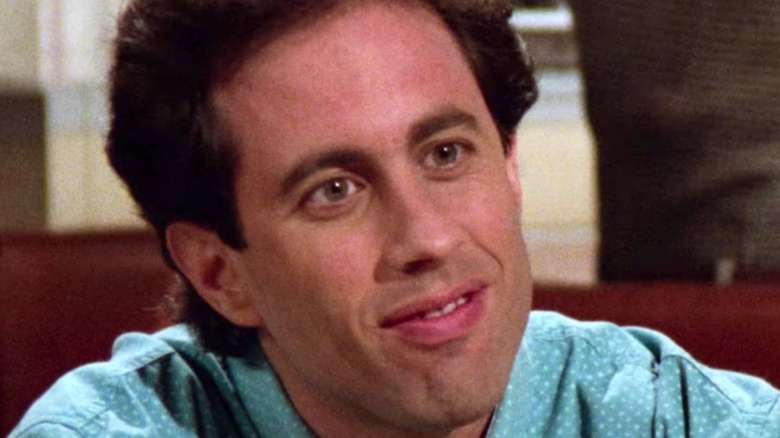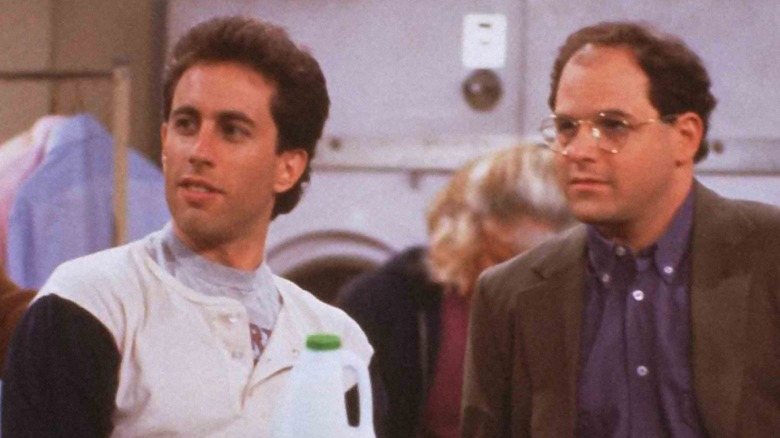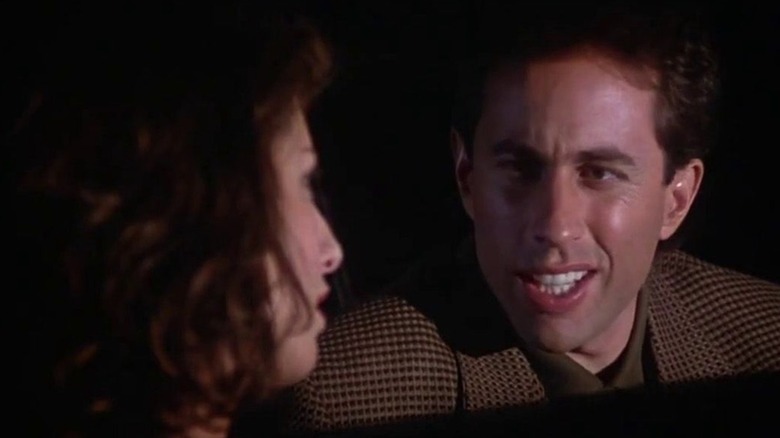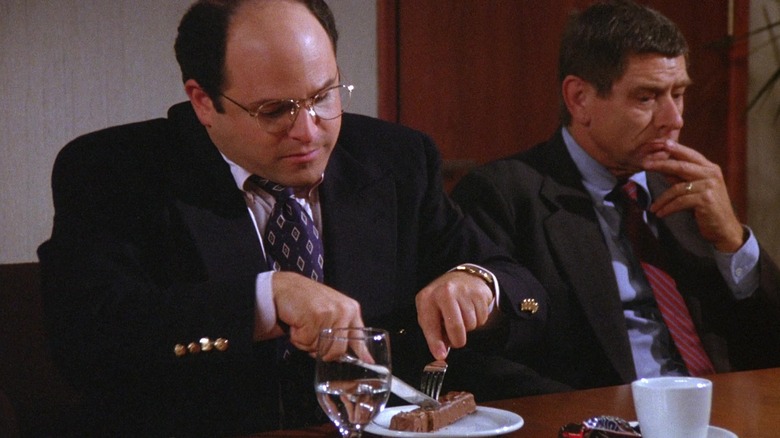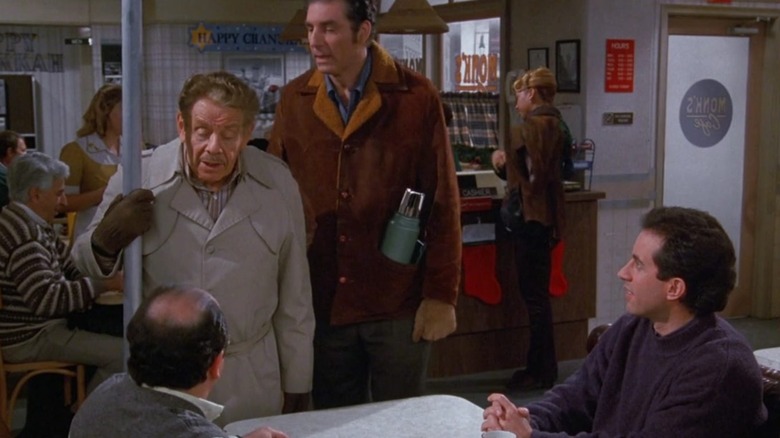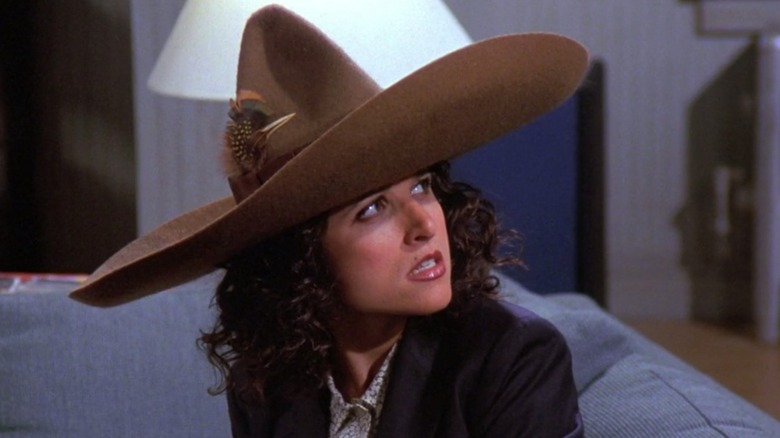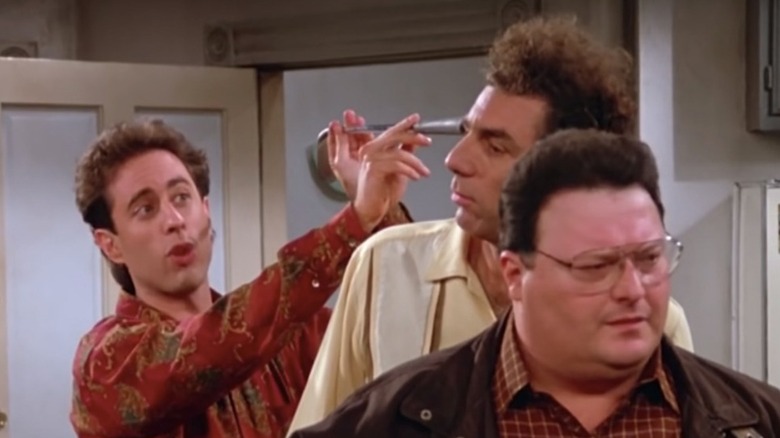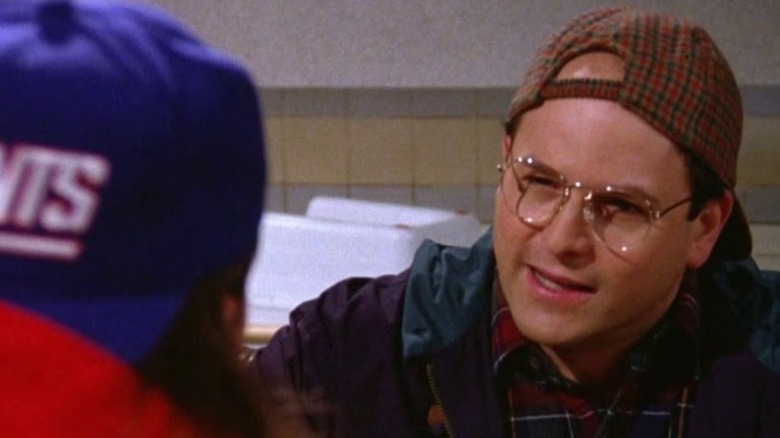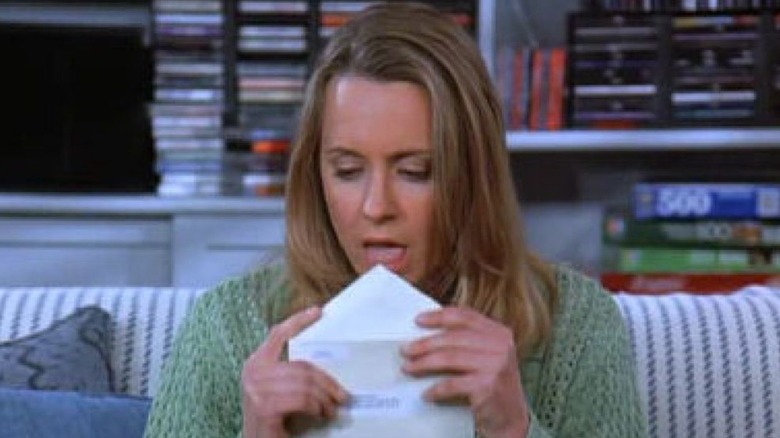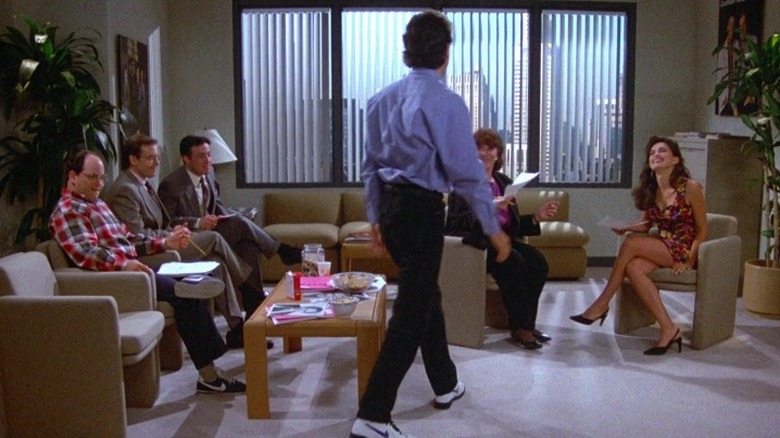Every Season Of Seinfeld Ranked From Worst To Best
Nothing is a paradox because there cannot be nothing unless there's something. "Seinfeld" is a show about nothing. It's also a show about something — something acerbic, something genuine, something original, and something timeless.
It doesn't matter if you watched "Seinfeld" on NBC during the '90s, via reruns on TBS in the '00s, on DVD or Blu-ray in the early '10s, or are streaming it for the first time today. No matter how you experience it, "Seinfeld" is gold. If, like me, you watched "Seinfeld" during all of those cycles, you know it's like Golden Boy: sure to come out crisp and vivid on every watch.
Like most shows, it took time for "Seinfeld" to find itself, and its tone evolved over time as it tried to stay ahead of the comedic curve set by contemporaries like "Fraiser," "Mad About You," and "Cheers." It's not easy ranking every season of "Seinfeld" — they're all wonderfully crafted — but, like Mr. Pitt staring at a 3D poster, a clear image starts to appear if you look at them long enough. Eventually, you see which moments, episodes, and seasons stand out. Here are all 9 seasons of "Seinfeld," ranked from worst to best.
9. Season 1
The buds of greatness are already growing in "Seinfeld" season 1, but have yet to blossom. Make no mistake: This is not the "Seinfeld" your coworker, cool uncle, and favorite television blogger hyped up. In season 1, the show about nothing does not quite fill that nothingness with original comedic situations. In "The Robbery," Jerry returns from tour and finds that his apartment was burglarized because Kramer left the door open. George offers Jerry a new apartment that he almost takes, which would allow Elaine to move into Jerry's place, but the plan falls apart. The episode's story doesn't grab you, and the characters don't butter you up with their antics. Like much of the season, it falls a little flat.
Still, season 1 has its moments. In the episode "Male Bonding," Kramer dreams up a do-it-yourself pizza joint. Everyone tells him that it's a bad idea, but Kramer's wide-eyed optimism and entrepreneurial spirit give a jolt to an episode that's otherwise about Jerry telling a childhood friend that he wants to "break up." It's those moments that pull season 1 of "Seinfeld" out of the fog and shine a light in the direction the series should, and ultimately does, move toward.
8. Season 2
In season 2 of "Seinfeld," the plots begin to percolate with the same kind of infectious pops as the opening theme. This is when the writers begin to explore what makes "Seinfeld" work: When life becomes monotonous, what would happen if you actually did that wild, socially unacceptable thing you've always thought about doing? What if you fire out that mean-spirited joke about ponies at dinner? What if you confront a former date at a baby shower in the shirt she ruined with your favorite chocolate sauce? "Seinfeld" delves into these relatable fantasies, some of which we viewers have dreamed about, too. Then, it goes one step further, asking: What if you do those things, and then the situation goes horribly wrong?
Season 2 has several standout scenes, but most of the episodes move with all the pace of a Louisiana vowel. In the episode, "The Ex-Girlfriend," George breaks up with a woman named Marlene because she drags out conversations with her southern drawl. Even though she irritates him, Jerry starts to date her. However, Marlene eventually sees Jerry's act and breaks up with him because she can't date someone if she doesn't respect what they do; an exasperated Jerry replies, "You're a cashier!"
In later seasons, the Marlene adventure would be just one of several storylines that make up an episode. In season 2, these kinds of plots have to support the entire installment. It's a tad irritating, but hilarious individual moments, like Marlene's breakup with Jerry, make it all worthwhile.
7. Season 6
Look, season 6 of "Seinfeld" is excellent. Let me rattle off its spectacular comedic nuggets: John Voight's convertible, Uma Thurman's smeared phone number, the uppity Snickers bar, the big salad, and the Manzere. That's a higher number of comedy highlights than we got during the entire runs of "Suddenly Susan," "Single Guy," and "Veronica's Closet" combined. However, by "Seinfeld" standards, they're merely good; the series' true greatness lies elsewhere.
In season 6, it feels like the writing staff found a solid formula, and relied on it over and over. Jerry confronts a rival. Jerry confronts a dry cleaner. Jerry confronts a regifter. In each case, the pattern is clear: The writers introduce a basic premise and a whimsical cast of supporting characters, then have them annoy Jerry while Kramer does something bonkers. It leads to some hilarious moments, but we've already seen that the show is capable of more. Season 6 yields some big laughs, but on the whole it's not a showstopper like some of the others.
6. Season 9
By the time that "Seinfeld" season 9 rolled around, the show was a legitimate phenomenon, pulling in tens of millions of viewers every Thursday. I used to tailgate with my friends before each episode. When 9 pm hit, we would sit on the edge of our seats, beer and cocktails untouched, silently (aside from our laughter) absorbing every moment. Then, during commercials, we'd shout out our favorite punchlines: "Serenity now," "Festivus for the rest of us," or even more obscure but hilarious bits like "You gotta mulch. You got to." I still quote those lines.
Season 9 took some chances that worked. In the episode "The Betrayal," Jerry, Elaine, and George go to a wedding in India, and the story is told in reverse, similar to the movie "Memento." In "The Merv Griffin Show," Kramer sets up the old "Merv Griffin" set in his apartment and hosts guests. Those are risky, high-concept ideas, but they're beboppin' all over the screen because they're executed well by a seasoned staff.
Unfortunately, the entire enterprise is hindered by a single episode. You know what it is: "The Finale." I understand wanting to pay homage to all of the series' fantastic characters, giving them a curtain call for helping make "Seinfeld" one of the most celebrated shows in television history. I don't understand why the clever minds who delivered such rich comedic experiences for the better part of nine years could not find a more fitting ending. Instead, we get a parade of characters who spew off their catchphrases one-by-one in a courtroom. It just doesn't meet the creative pedigree established in the previous 170-plus episodes.
5. Season 8
Despite being one of the four main characters on "Seinfeld," it's not until season 8 that Elaine is given a prominent story arc. Miss Benes takes over as the CEO of the J. Peterman Catalog, and immediately begins delivering sublime failures that are so epic that they've become burned into our collective consciences. Who can forget the "urban sombrero," Elaine's herky-jerky dancing, or the time she broke the spirit of the PTSD-scarred Frank Costanza?
Let's not forget the younger Costanza, either. George cannot escape Susan's legacy in "The Foundation," in which he founds a charitable organization in memory of his late fiancée. For the rest of the season, it serves as a constant reminder of what could have been if he wasn't so, well, George.
Kramer doesn't get a story arc, but season 8 shows what an asset he is to the series. Kramer forces Jerry and company to interact a host of oddball characters, like the bootlegger, Dominican cigar rollers, Mr. Marbles, and Izzy Mandelbaum Sr. All of them push the strait-laced Jerry outside of his comfort zone. Some of the characters are a little cartoonish, but that's what Kosmo Kramer brings to this quartet: an offbeat rhythm that makes the others play along to his beat.
4. Season 3
"Seinfeld" season 3 is grounded in reality. In the first two seasons, we meet some oddballs, but the stories are not yet exaggerated in the way they are later. In season 3, though, our four hilarious and lovable jerks turn New York into their personal playground. They're on the street, they're at the diner, and they're at the airport. Along the way, we start to understand their motivations, and begin to predict how they'll respond to various situations. The writers cleverly utilize that familiarity to set us up for the season's biggest punchlines.
We know that Kramer is going to zero-in George's girlfriend's large schnoz, but we don't know how she'll handle it. We know that Elaine wants to break up with her 66-year-old boyfriend after he has a stroke, but we don't know how long she'll care for him first. We know that Jerry and George are going to regret sneaking into a limo while pretending to be other people, but we don't know how far the writers will go to make them regret it (very far, as it turns out).
Season 3 also has two of the series' most breathtaking episodes: "The Boyfriend," featuring Keith Hernandez as himself, and "The Library," which starred the late Phillip Baker Hall as Lt. Joe Bookman. However, while you can watch many of these episodes dozens of times and still laugh (I do), there are some clunkers that stall out after a handful of viewings. For instance, "The Truth" has a weak premise and doesn't deliver laughs –- it feels like it was carried over from season 2.
3. Season 5
Jerry does a great job of being a surrogate normie in this world of wackos, and his stability really starts to take shape in season 5. In "The Hamptons," Jerry is the sympathetic confidant to George when the latter confesses about his shrinkage situation. In "The Pie," he's the accomplice who helps steal the bare-naked mannequin that bears a striking resemblance to Elaine. In "The Stand In," he's properly stunned when the man he sets Elaine up with flashes her.
However, it becomes so clear that Jerry represents the viewers, who share in his shame, humility, and sympathy, that the writers eventually have to make fun of it. In "The Opposite," Kramer dubs Jerry "Even Steven" after he loses a job, only to land a replacement gig just minutes later. Jerry's steadiness starts to impact his friends, too. George, who is unemployed and lives with his parents, turns his life around, while Elaine loses her boyfriend, apartment, and job. George is up. Elaine is down.
Season 5 is much like the dichotomy between those two characters. It lifts you up with incredible episodes like "The Puffy Shirt," "The Stall," and "The Marine Biologist," but occasionally weighs you down with ho-hum episodes like "The Glasses." If you watch "The Glasses," it's clear what's not working: Jerry's plotline doesn't carry enough weight to keep the other storylines balanced.
2. Season 7
If there's any question that "Seinfeld" captured the zeitgeist, consider this: Season 7 of the show aired more than a quarter century ago, yet people still conversationally say "No soup for you," "spongeworthy," and "schmoopie." Really, though, season 7's enduring watchability comes down to one factor: Susan. Her engagement to George completely derails his journey, sending him into a panic as his old, self-indulgent life comes to an end.
Susan's presence also gives "Seinfeld" a way to explore the show's more established characters in new ways. Elaine and Jerry's loyalty to George wavers when they start hanging out with Susan in "The Pool Guy." The contrast between George's boorish parents and Susan's refined folks drives much of "The Rye." George's fidelity is tested (and fails) after he finds out that he is Marissa Tomei's type. Kramer seems to be the only one not impacted by the new addition to his social circle; he cares so little that he thinks Susan is named Lily.
As the season advances, the pressure around George increases until everything bursts in the season finale, "The Invitations." You know what happens. I know what happens. But it's still fun to watch the show build to the moment that the doctor tells George about Susan's fate. Further, after the weight of his engagement is lifted, you think things are finally going to start going George's way. Instead, the end-credits scene immediately squashes that hope. George calls Marisa Tomei to tell her his fiancée is dead. She immediately hangs up on him. Fade to black. Season 7 essentially says, "That's it for me," and walks off.
1. Season 4
I don't know what's more impressive about this season: the overarching story arcs, or the dozens of laugh-out-loud moments peppered throughout. The plots involving Crazy Joe Davola and George dating Susan help develop the characters in ways that we hadn't seen in the previous three seasons, but it's the story about the TV pilot that lifts "Seinfeld" to the pinnacle of "Must See TV." George and Jerry's difficulties writing a script, the awkward interactions between the foursome and the actors playing them, and Jerry and George's efforts to appease NBC management, which can apparently be derailed by the merest glimpse of cleavage, are all standout moments.
Those big concepts create a framework that ably supports season 4's best material. The fight over "the moops" in "The Bubble Boy." Jerry sharing his dirty talk with George in "The Cheever Letters." Kramer shouting "I'm out" just minutes into "The Contest." Jerry learning that "they're real and they're spectacular" in "The Implant." I've seen these bits dozens of times over the last three decades, and I plan to watch them, and all the others, even more in the decades ahead. They are delicious, scrumptious, outstanding — and I'm out there loving every minute of it!
